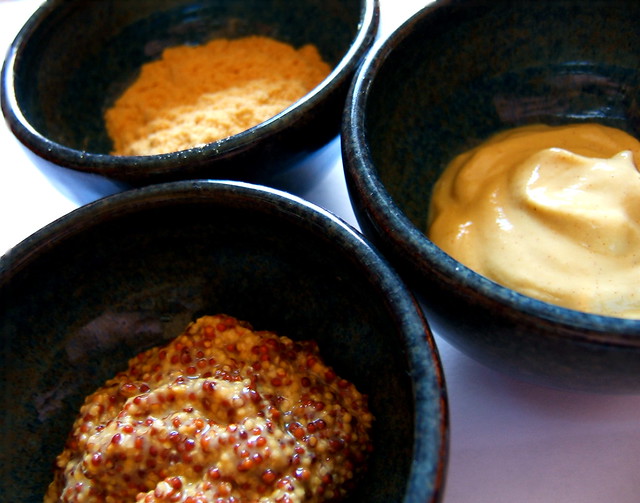 |
| © 2006 Jessica Spengler, Flickr | CC-BY | via Wylio |
The first recipe we have for mustard comes from the famous
forth (or fifth) century Roman cookbook “Apicus”. It calls for ground mustard
seed to be mixed with unfermented grape juice, also know as “must”, along with
pepper, caraway, dill, celery, thyme, onion, honey, vinegar fish sauce and oil.
This “burning must” – mustum ardens in Latin – was eventually shortened
and gave us the word “mustard”. Romans considered it a great accompaniment to
roast boar but also found it useful to cure toothaches, stimulate appetite and
digestion, clear the sinuses and increase blood circulation. Try to get all
that out of a bottle of ketchup!!
Dry yellow mustard powder is actually
very mild in taste. The heat of a mustard preparation doesn’t come about until
it’s mixed with a liquid. Ground yellow mustard makes for a milder preparation
than either black or brown Indian mustard. Additionally, the temperature of the
preparation makes a difference. Really fiery mustards are made with cold water
and small amounts of mild acids, such as vinegars. Milder mustards are made
with hot water and stronger acids that break down the “heat” of the sauce.
Commercial “yellow mustard”,
also known as “American mustard” has a large amount of turmeric added to give
it its characteristic yellow colour. Dijon mustard was first made in the Dijon
region of France in the mid 1800s when a cook substituted verjuice (an unfermented grape juice) for vinegar in a classic
recipe. Today, Dijon mustards are mostly made with white wine over verjuice and very little of it is
produced in Dijon France anymore. Interestingly enough, even the mustards made
in Dijon are made almost exclusively with Canadian grown mustard seeds. Canada
produces between 70 and 80 percent of the world’s exported mustard seed, mostly
in Alberta and Saskatchewan.
In addition to being a great and versatile condiment, mustard also performs the useful task of being an inexpensive emulsifier.
In addition to being a great and versatile condiment, mustard also performs the useful task of being an inexpensive emulsifier.
Mustard has an extremely long
shelf life, both in seed, powdered or prepared form. Mustard has natural
antibacterial properties and does not require refrigeration as it does not
support molds, mildews or harmful bacterial growth. Prepared mustards will lose
their pungency over time. The flavour elements that were released with the
addition of liquid can evaporate so keep your mustard in a tightly sealed
container and out of direct sunlight.
No comments:
Post a Comment
Comment? Question? Criticism? New idea? Want to volunteer? Feel free to leave us a message.